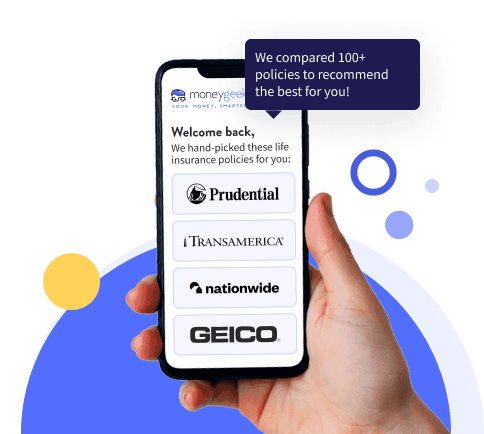Buying life insurance doesn't have to feel overwhelming. You can secure financial protection in six to eight weeks by following eight steps, from determining coverage needs to activating your policy:
How to Buy Life Insurance: Complete Guide (2025)
To buy life insurance that best suits your needs, choose the right policy type, figure out how much coverage you need and shop around for the best rates.
Find out if you're overpaying for life insurance below.

Updated: December 12, 2025
Advertising & Editorial Disclosure
Life insurance premiums vary widely between insurers, even for the same coverage amount. Comparing quotes saves you hundreds over your policy's lifetime.
Term life insurance costs less than other types and works well when you need coverage for a specific reason, like replacing your income or covering your mortgage until it's paid off.
Whole life insurance works better for complex financial planning situations. It lasts your entire life and builds cash value you can borrow against, but you'll pay more for these features.
You may need to complete a medical exam when applying, but no-exam policies are available (often at a higher cost) for those who qualify.
Ensure you are getting the best rate for your insurance. Compare quotes from the top insurance companies.
How to Purchase Life Insurance
1. Assess Your Coverage Needs
Before you apply, determine how much coverage you'll need based on income, debts, dependents and long-term financial goals. A common starting point is 10 to 12 times your annual salary. Key factors to consider:
Factor | Description |
|---|---|
Income replacement | Make sure your family can maintain their lifestyle if you’re no longer around. |
Debt payoff | Cover major debts like mortgages, student loans and credit cards. |
Future expenses | Factor in expenses like college tuition or childcare for young kids. |
Dependents | Having more dependents requires more coverage. |
Savings and investments | Existing assets can offset how much life insurance you need. |
End-of-life costs | You may want your policy to cover funeral and burial expenses. |
Understanding your coverage needs helps you choose a policy that provides the right level of financial protection without overpaying for unnecessary coverage. Use our life insurance calculator below to get a personalized estimate:
How Much Life Insurance Do You Need?
Answer three simple questions to get your recommended coverage amount.
2. Decide What Type of Life Insurance to Get
When buying life insurance, it's important to consider the different types of policies that are available. The most common policies are term life insurance and whole life insurance:
Coverage Duration | Specific period (10, 20, or 30 years) | Lifelong coverage |
Death Benefit | Paid only if death occurs during the term | Guaranteed payout regardless of when death occurs |
Cash Value Component | None | Yes, grows tax-deferred over time |
Policy Expiration | Expires without value if the term ends (unless converted) | Never expires |
Premium Cost | Low, affordable | Much higher (hundreds of dollars more monthly) |
Best For | People needing coverage for a specific period (e.g., raising family, paying mortgage, income replacement during working years) | High-income earners, long-term planners, wealth preservation, estate tax coverage, lifelong support for dependents with special needs |
Explore Companies |
Learn More: Term vs. Whole Life Insurance
3. Consider Riders and Additional Coverage
A life insurance rider is an optional addition that provides extra benefits or coverage. Popular riders include:
- Accidental death benefit rider: Provides an additional death benefit if your death is due to an accident
- Waiver of premium rider: Waives premiums if you become seriously ill or disabled
- Accelerated death benefit rider: Allows you to access a portion of your death benefit while still alive if diagnosed with a terminal illness
- Child rider: Provides a death benefit if one of your children dies
- Guaranteed insurability rider: Allows you to buy additional coverage in the future without evidence of insurability
4. Compare Life Insurance Companies and Get Quotes
Your next step is comparing life insurance quotes from multiple providers to find the best combination of coverage and cost. Compare at least three to five companies before deciding, as premiums vary between insurers, even for identical coverage. If you're in good health, get quotes that include a medical exam to maximize savings. No-exam life insurance works better if you need coverage quickly, though premiums are more expensive.
When comparing life insurance policies, it's important to look beyond the premium. Financial strength ratings, for example, indicate whether the company can pay your beneficiaries decades from now. Check ratings from A.M. Best, Moody's or Standard & Poor's, looking for A+ or higher. You should also review customer service reputation and claims processing speed through third-party ratings from J.D. Power.
To make your research easier, explore our guides to the best life insurance companies based on different needs:
5. Choose Your Life Insurance Beneficiary
Selecting a beneficiary for your life insurance policy affects your family's financial future. Factors to consider:
Factor | Consideration |
|---|---|
Primary vs. Contingent | Designate a primary beneficiary who will receive the death benefit and a contingent or secondary beneficiary as a backup. The secondary beneficiary gets the benefit if the primary beneficiary passes away before you. |
Multiple Beneficiaries | You can name more than one person and decide how the benefit is divided among them. Consider the distribution method that suits your wishes. |
Legal Considerations | Your choice must comply with state laws, especially if considering a minor as a beneficiary. In such cases, set up a custodial account or designate a trusted guardian to manage the benefit until the minor reaches adulthood. |
Regular Updates | Life situations change, and so should your beneficiary designations. Review and update them regularly to ensure your named beneficiaries know when and where to file a claim. |
Trusts and Legal Entities | If you have specific requirements for how the funds should be used, creating a trust and naming it as your beneficiary helps control how funds are used. |
6. Complete the Application and Medical Exam (If Required)
Insurance companies want to know about your background and lifestyle. As you complete life insurance applications, expect to include the following information: age, gender, occupation, income level, number of dependents and medical history. Your lifestyle habits (like smoking, drinking, exercise and risky hobbies) also affect your rates.
Most insurers send a licensed health professional to your home or office for a medical exam checking height, weight and blood pressure. Blood and urine lab work screens for diabetes, high cholesterol and smoking. If you're healthy, taking this exam lowers your premiums, though some companies offer policies that don't require a medical exam in exchange for higher premiums.
Read more: Best No-Exam Life Insurance
7. Review and Accept Your Policy
Once your application is approved, you'll receive your policy documents. Review the details thoroughly before signing:
- Confirm that your name, address and Social Security number are correct
- Verify your age and birth date match your records
- Check that your occupation is listed accurately
- Ensure the death benefit amount matches what you applied for
- Review the premium amount and payment schedule
- Check the policy start date and term length
- Verify all beneficiary information
Contact your agent or the insurance company immediately. Most issues can be resolved quickly with a policy amendment. Don't accept the policy until all corrections are made. Fixing errors after acceptance takes much longer.
Checkpoint: All policy details should match your application before you sign and return the acceptance forms.
8. Activate and Maintain Your Coverage
Your policy doesn't protect anyone until you pay that first premium. You have 30 days to pay, but you should pay right away to eliminate any coverage gap. One missed premium voids your entire policy, so consider setting up automatic payments now to ensure your coverage never lapses.
Your life isn't static, and neither should your life insurance be. Set a yearly reminder to review your policy, especially after major changes like getting married, having children, buying a home, or changing jobs.
Why Should You Buy Life Insurance?
Life insurance protects your family financially when you're gone, ensuring your dependents are supported. Ways life insurance supports your long-term financial plan:
Life insurance ensures your family maintains their standard of living, even without you. It covers daily living expenses, mortgage payments, educational costs and more.
If you pass away with outstanding debts like personal loans or credit card balances, life insurance pays them off, relieving your family from the burden.
Life insurance provides a tax-free inheritance to your heirs. It can cover estate taxes, protecting your assets' value and ensuring your legacy is passed on according to your wishes.
Some life insurance policies like whole life or universal life offer investment opportunities with cash value growth you can borrow against or withdraw.
Life insurance lets you leave a lasting legacy by contributing to a charity through your policy. By naming a charitable organization as a beneficiary, you can support a cause even after your lifetime.
Where to Buy Life Insurance
You have several ways to purchase life insurance, depending on how much guidance or convenience you prefer:
Licensed professionals who can recommend policies tailored to your financial goals and walk you through the process.
Many insurers let you compare quotes, apply and buy coverage entirely online. This is ideal if you want speed and control.
Some employers include group life insurance in their benefits package. It's easy to enroll and often comes at a lower cost, but coverage may be limited.
These professionals can help you choose a policy that fits within your broader financial strategy, especially if you're juggling multiple goals.
Certain groups or associations provide access to exclusive plans with negotiated rates or simplified underwriting.
Ensure you are getting the best rate for your insurance. Compare quotes from the top insurance companies.
Shopping for Life Insurance: FAQ
We answer common questions about buying life insurance:
Is it better to buy life insurance online or through an agent?
Buying online offers speed and easy comparisons, while agents provide personal guidance. Choose based on whether convenience or advice matters more.
How long does it take to buy life insurance?
No-exam policies may be approved in days, while full underwriting takes four to six weeks depending on your health and insurer.
Do you need a medical exam to buy life insurance?
Some policies require a medical exam to finalize your rate. No-exam options exist but typically cost more for older or less healthy applicants.
What information do I need to apply for life insurance?
Insurers ask for ID, income details, medical history and lifestyle habits. Preparing this in advance speeds up the process.
Is life insurance required?
Life insurance isn't legally required, but it's highly recommended if you have dependents or financial obligations like mortgages, debts or education expenses that your loved ones would need to cover after your passing.
Related Articles
About Mark Fitzpatrick

Mark Fitzpatrick, a Licensed Property and Casualty Insurance Producer, is MoneyGeek's resident Personal Finance Expert. With over five years of experience analyzing the insurance market, he conducts original research and creates tailored content for all types of buyers. His insights have been featured in publications like CNBC, NBC News and Mashable.
Fitzpatrick holds a master’s degree in economics and international relations from Johns Hopkins University and a bachelor’s degree from Boston College. He's also a five-time Jeopardy champion!
He writes about economics and insurance, breaking down complex topics so people know what they're buying.








